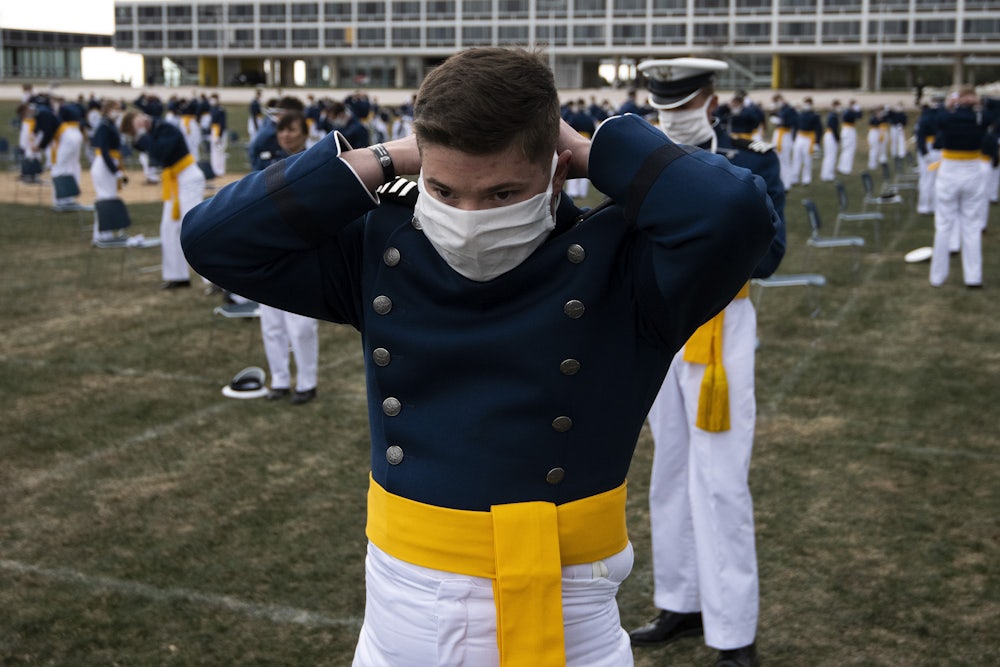Earlier this month, the Pentagon inked a contract to pay $818 million to Lockheed for hundreds of new extended-range, air-launched cruise missiles with thousand-pound explosive warheads. By then, Americans had learned that America’s Strategic National Stockpile—the federal emergency medical supply cache, whose annual budget is less than that missile contract—faced critical shortages of ventilators and even N95 respirator masks, which retail (in ordinary times) for 60 to 80 cents.
“How many of the 4,000 nuclear weapons that the United States will spend $50 billion on this year (and next and next and next) would you trade for enough ventilators, masks, ICU beds, and test kits right now?” arms-control expert and former Obama national security aide Jon Wolfsthal had tweeted in late March. It shouldn’t be a purely rhetorical question. The Department of Defense’s budget is three-quarters of a trillion dollars; the rough amount it spent on Lockheed’s cruise missile contract alone “could buy 20,000 high-end ventilators,” as defense technology writer Kelsey Atherton points out.
These arguments are growing in frequency and volume as we confront the macabre ongoing failure of one of the world’s richest societies to provide the simplest protections to its medical workers in a crisis. The argument usually rests on a “return on investment” mindset: We can save many more lives per dollar if those dollars are spent on masks instead of cruise missiles, so why haven’t we?
One common answer is that the process is politicized: The power of big defense contractors means that money flows toward weapons. But this just raises the question of why don’t we pay, or even overpay, defense contractors to produce vital medical equipment the way we do for bombs. I would argue that a gender lens has real explanatory power for that.
A foundational insight of gender analysis in political science is that roles and actions coded as feminine are valued less in our society than those that are coded as masculine. The easiest way to see this is to think about occupations that have long been considered “women’s work”: Roles like teacher, nurse, or daycare worker are traditionally lower paid. Fascinatingly, we can see this operating in real time now, as well: When women recently made up a majority of gynecological surgeons for the first time, a rapid devaluing of the specialty within the medical field followed.
One could hardly design a more stereotypical gendered dichotomy than “missiles versus medical masks.” Beyond their unsubtle phallic symbolism, missiles are engineered to protect through aggression: lock onto a target, penetrate its defenses, and subdue it in an explosive climax. Strong militaries for mighty nations lob missiles; their soldiers may occasionally bear weighty, intimidating medical gear to brave a chemical or biological attack, but they don’t cower in the passive protection of medical masks: Those are the province of caregivers and health providers, feminine-coded professions.
Interestingly, a few social media critics have noted the similarities between medical providers’ DIY protective gear—like soda-bottle masks and garbage bags-turned-medical gowns—and the improvised “hillbilly armor” that U.S. soldiers in Iraq once rigged onto their thin-skinned Humvees to protect them from explosive attacks on patrol. Back then, when some of those soldiers asked Defense Secretary Donald Rumsfeld about having to scrounge protective coverings for their vehicles, he famously shrugged them off. “You go to war with the Army you have,” he said. Then as now, even within the military, leaders devalue “passive” force-protection measures when compared with aggressive capabilities.
“When you come out of the Academy,” a junior Army officer and U.S. Military Academy alumnus once wrote, “you want to make an impact, but you have some blinders. One of those is gender.” This was the insight the soldier took away from a training evolution at West Point in which he’d been paired with a woman from my institute’s Women Waging Peace network in Nepal; the network includes over 1,000 women leaders from 56 countries working to build peace and reduce violence. Part of the network’s practical value lies in teaching privileged men like that Army officer—and me—where our cultural blinders are. They have taught us to see how gender dynamics structure every aspect of the world we live in.
They are able to do this not simply because they are women, but because to succeed as leaders they themselves have had to understand at a fundamental level how gender impacts them and how it creates challenges and opportunities. To be effective at what they do, they have had to see things that other traditional leaders in their countries have not, to tap into different sources of power, and to create different kinds of relationships and coalitions.
“The research shows that women’s leadership in local government results in better outcomes on issues of safety and security for marginalized communities,” write three of these women—the mayors of Dayton, Ohio; Escobedo, Mexico; and Colombo, Sri Lanka—in a powerful recent essay on reducing urban violence. “Women lawmakers are more responsive to the needs of all populations and tend to invest more in cities’ education, health, and infrastructure policies.”
This shows a rare kind of leadership we need to confront the coronavirus crisis in America. We have learned in this pandemic and in previous ones that the most important acts and objects involved in mitigating the dangers—social distancing, masking—are coded as passive and feminine and therefore undervalued by our society in its national-security rhetoric or disaster-planning. It is striking, and not well-enough studied, that female government leaders in Taiwan, New Zealand, and Germany have gained considerable plaudits for their responses to the crisis.
Of course, just getting women to the leadership tables where key decisions on pandemic response are being made won’t guarantee better outcomes. But if Americans truly care about removing the blind spots that caused us to have plenty of missiles and not enough 60-cent masks, it’s the right place to start.
